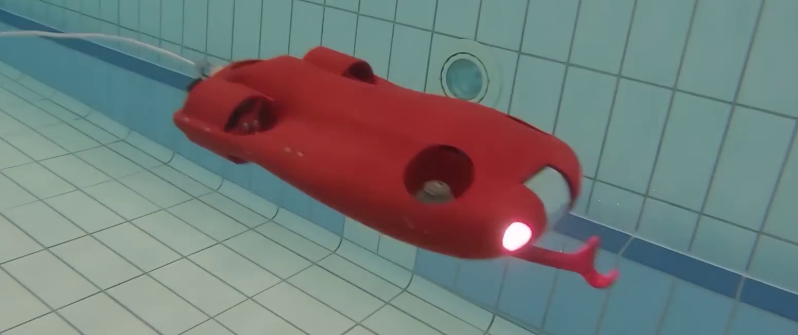Building an underwater remotely operated vehicle (ROV) is always a challenge, and making it waterproof is often a major hurdle. [Filip Buława] and [Piotr Domanowski] have spent four years and 14 prototypes iterating to create the CPS 5, a 3D printed ROV that can potentially reach a depth of 85 m.
FDM 3D prints are notoriously difficult to waterproof, thanks to all the microscopic holes between the layers. There are ways to mitigate this, but they all have limits. Instead of trying to make the printed exterior of the CPS 5 waterproof, the electronics and camera are housed in a pair of sealed acrylic tubes. The end caps are still 3D printed, but are effectively just thin-walled containers filled with epoxy resin. Passages for wiring are also sealed with epoxy, but [Filip] and [Piotr] learned the hard way that insulated wire can also act as a tube for water to ingress. They solved the problem by adding an open solder joint for each wire in the epoxy-filled passages.
For propulsion, attitude, and depth control, the CPS 5 has five brushless drone motors with 3D printed propellers, which are inherently unaffected by water as long as you seal the connectors. The control electronics consist of a PixHawk flight controller and a Raspberry Pi 4 for handling communication and the video stream to a laptop. An IMU and water pressure sensor also enable auto-leveling and depth hold underwater. Like most ROVs, it uses a tether for communication, which in this case is an Ethernet cable with waterproof connectors.
Acrylic tubing is a popular electronics container for ROVs, as we’ve seen with an RC Subnautica sub, LEGO submarine, and the Hackaday Prize-winning Underwater Glider.
















I wonder if they’ve sprayed the inside with that Dip-it spray rubber stuff. Would that work?
Doesn’t sound like he needed it. The sensitive circuitry had its own, inner, pressure hull.
It may work for surface vessel water proofing, but for underwater application where the water proof barrier may be subjected to significant pressure it would likely fail/leak. Putting the water proof barrier on the outside would work better for underwater applications, the hull structure will support the water proof barrier and the water proof barrier/coating will fill in any tiny path ways that would allow the water to penetrate the hull structure.
I am currently building an ROV as well. I ran into the exact same problems and more or less solved them im the same way.
https://hackaday.io/project/185615-turbo-super-submarine
But i stole the idea with the solder joints to stop water leaking through the cables from a different place.
A few years ago “der 8auer” build a PC with its components completly emerged in cooling liquid. The stuff would evaporate and cool the components.
He recycled the coolent so the case had to be sealed. But there would be a preasure build up in the case that would push the liquid into the cabels (screen, mouse, keyboard, …).
In the end he had to make a pcb with connectors at front and back and glue that into the backwall of the case.
So thats the same problem but in the oposite direction ^^.
Wouldn’t it be better to have the o-rings sealing the acrylic tube press against the ends of the tube instead of the inside? That way the water pressure would work with the seal instead of against it.
A properly designed o ring seal uses deformation of the ring to seal. With o-rings on the inside water can only press on them from the outside direction, which pushes the ring tighter. If the o ring were on the end of the tube water could work it’s way under the ring between the tube end. You could tighten the ring harder against the end, but that has diminishing returns, eventually you would squeeze the ring out of position. You could solve that by making retention grooves on the end, but then you might as well save the effort and just put the ring inside the tube.
These guys have been trying to monetize their “course” for years. Hawking it across different 3d printing (and open source, lol) communities to little avail.
Of course, this is only a course and outside of some amateur writing they make nothing available to the suckers who buy into it. Nothing better than people who abuse open source communities in a poor attempt to make money.
Somewhere they say it’s open source, it’s not true? the CAD models are not available? Can’t seem to find them in the website
We’ve started this project as a hobby, which naturally lead us to want to open-source everything. We’ve never actually accomplished it, because we wanted very comprehensive instructions to go with it (published some of it on instructables). Since we wanted to continue working on underwater drones, as a way of making money, we tried to sell DIY kits. After shipping some, we’ve quickly realized that it’s really hard to make them usable & at scale at the same time.
So in March 2022 we decided to try a different approach and unfortunately drop the open-source aspect. During a few months we wrote a very comprehensive DIY course on how to build the drone + theory about underwater vehicles + how to do it differently + of course access to all the files. You buy the components yourself & you can use our BOM to do so.
It works and there’re people who built the drone using this course.
To me the course price is too high for diy project. Also a bit sceptical as it is or more like was mixed with open source. I’d rather have less work put in lessons and lower price 🙂